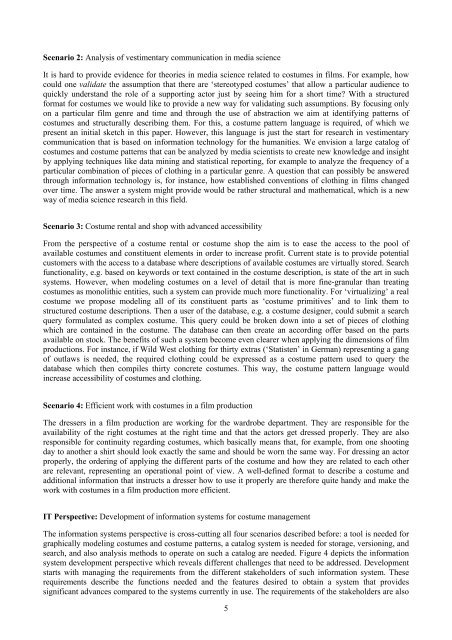A Pattern Language for Costumes in Films - IAAS
A Pattern Language for Costumes in Films - IAAS
A Pattern Language for Costumes in Films - IAAS
You also want an ePaper? Increase the reach of your titles
YUMPU automatically turns print PDFs into web optimized ePapers that Google loves.
Scenario 2: Analysis of vestimentary communication <strong>in</strong> media science<br />
It is hard to provide evidence <strong>for</strong> theories <strong>in</strong> media science related to costumes <strong>in</strong> films. For example, how<br />
could one validate the assumption that there are ‘stereotyped costumes’ that allow a particular audience to<br />
quickly understand the role of a support<strong>in</strong>g actor just by see<strong>in</strong>g him <strong>for</strong> a short time? With a structured<br />
<strong>for</strong>mat <strong>for</strong> costumes we would like to provide a new way <strong>for</strong> validat<strong>in</strong>g such assumptions. By focus<strong>in</strong>g only<br />
on a particular film genre and time and through the use of abstraction we aim at identify<strong>in</strong>g patterns of<br />
costumes and structurally describ<strong>in</strong>g them. For this, a costume pattern language is required, of which we<br />
present an <strong>in</strong>itial sketch <strong>in</strong> this paper. However, this language is just the start <strong>for</strong> research <strong>in</strong> vestimentary<br />
communication that is based on <strong>in</strong><strong>for</strong>mation technology <strong>for</strong> the humanities. We envision a large catalog of<br />
costumes and costume patterns that can be analyzed by media scientists to create new knowledge and <strong>in</strong>sight<br />
by apply<strong>in</strong>g techniques like data m<strong>in</strong><strong>in</strong>g and statistical report<strong>in</strong>g, <strong>for</strong> example to analyze the frequency of a<br />
particular comb<strong>in</strong>ation of pieces of cloth<strong>in</strong>g <strong>in</strong> a particular genre. A question that can possibly be answered<br />
through <strong>in</strong><strong>for</strong>mation technology is, <strong>for</strong> <strong>in</strong>stance, how established conventions of cloth<strong>in</strong>g <strong>in</strong> films changed<br />
over time. The answer a system might provide would be rather structural and mathematical, which is a new<br />
way of media science research <strong>in</strong> this field.<br />
Scenario 3: Costume rental and shop with advanced accessibility<br />
From the perspective of a costume rental or costume shop the aim is to ease the access to the pool of<br />
available costumes and constituent elements <strong>in</strong> order to <strong>in</strong>crease profit. Current state is to provide potential<br />
customers with the access to a database where descriptions of available costumes are virtually stored. Search<br />
functionality, e.g. based on keywords or text conta<strong>in</strong>ed <strong>in</strong> the costume description, is state of the art <strong>in</strong> such<br />
systems. However, when model<strong>in</strong>g costumes on a level of detail that is more f<strong>in</strong>e-granular than treat<strong>in</strong>g<br />
costumes as monolithic entities, such a system can provide much more functionality. For ‘virtualiz<strong>in</strong>g’ a real<br />
costume we propose model<strong>in</strong>g all of its constituent parts as ‘costume primitives’ and to l<strong>in</strong>k them to<br />
structured costume descriptions. Then a user of the database, e.g. a costume designer, could submit a search<br />
query <strong>for</strong>mulated as complex costume. This query could be broken down <strong>in</strong>to a set of pieces of cloth<strong>in</strong>g<br />
which are conta<strong>in</strong>ed <strong>in</strong> the costume. The database can then create an accord<strong>in</strong>g offer based on the parts<br />
available on stock. The benefits of such a system become even clearer when apply<strong>in</strong>g the dimensions of film<br />
productions. For <strong>in</strong>stance, if Wild West cloth<strong>in</strong>g <strong>for</strong> thirty extras (‘Statisten’ <strong>in</strong> German) represent<strong>in</strong>g a gang<br />
of outlaws is needed, the required cloth<strong>in</strong>g could be expressed as a costume pattern used to query the<br />
database which then compiles thirty concrete costumes. This way, the costume pattern language would<br />
<strong>in</strong>crease accessibility of costumes and cloth<strong>in</strong>g.<br />
Scenario 4: Efficient work with costumes <strong>in</strong> a film production<br />
The dressers <strong>in</strong> a film production are work<strong>in</strong>g <strong>for</strong> the wardrobe department. They are responsible <strong>for</strong> the<br />
availability of the right costumes at the right time and that the actors get dressed properly. They are also<br />
responsible <strong>for</strong> cont<strong>in</strong>uity regard<strong>in</strong>g costumes, which basically means that, <strong>for</strong> example, from one shoot<strong>in</strong>g<br />
day to another a shirt should look exactly the same and should be worn the same way. For dress<strong>in</strong>g an actor<br />
properly, the order<strong>in</strong>g of apply<strong>in</strong>g the different parts of the costume and how they are related to each other<br />
are relevant, represent<strong>in</strong>g an operational po<strong>in</strong>t of view. A well-def<strong>in</strong>ed <strong>for</strong>mat to describe a costume and<br />
additional <strong>in</strong><strong>for</strong>mation that <strong>in</strong>structs a dresser how to use it properly are there<strong>for</strong>e quite handy and make the<br />
work with costumes <strong>in</strong> a film production more efficient.<br />
IT Perspective: Development of <strong>in</strong><strong>for</strong>mation systems <strong>for</strong> costume management<br />
The <strong>in</strong><strong>for</strong>mation systems perspective is cross-cutt<strong>in</strong>g all four scenarios described be<strong>for</strong>e: a tool is needed <strong>for</strong><br />
graphically model<strong>in</strong>g costumes and costume patterns, a catalog system is needed <strong>for</strong> storage, version<strong>in</strong>g, and<br />
search, and also analysis methods to operate on such a catalog are needed. Figure 4 depicts the <strong>in</strong><strong>for</strong>mation<br />
system development perspective which reveals different challenges that need to be addressed. Development<br />
starts with manag<strong>in</strong>g the requirements from the different stakeholders of such <strong>in</strong><strong>for</strong>mation system. These<br />
requirements describe the functions needed and the features desired to obta<strong>in</strong> a system that provides<br />
significant advances compared to the systems currently <strong>in</strong> use. The requirements of the stakeholders are also<br />
5
















